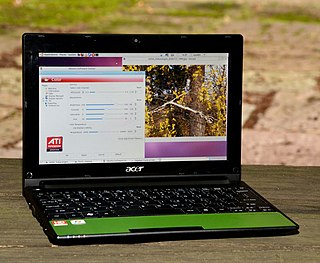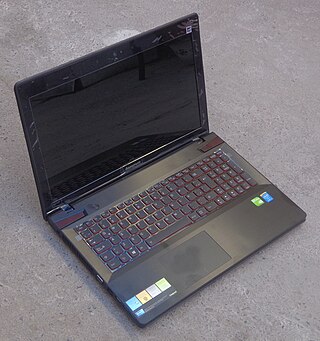Related Research Articles

Dell XPS is a line of consumer-oriented laptop and desktop computers manufactured by Dell since 1993.

The Panasonic Toughbook is a line of rugged computers produced and marketed by Panasonic. The first model, the CF-25, was introduced in 1996. The Toughbook brand mainly competes with other lines of rugged computers, such as Dell's Rugged Extreme.
A hybrid drive is a logical or physical computer storage device that combines a faster storage medium such as solid-state drive (SSD) with a higher-capacity hard disk drive (HDD). The intent is adding some of the speed of SSDs to the cost-effective storage capacity of traditional HDDs. The purpose of the SSD in a hybrid drive is to act as a cache for the data stored on the HDD, improving the overall performance by keeping copies of the most frequently used data on the faster SSD drive.

The Qosmio series was Toshiba's consumer-marketed line of high performance desktop replacement laptops. The laptop was first released on July 25, 2004 as the E15-AV101 with a 1.7 GHz Intel Pentium M CPU, 512 megabytes of DDR SDRAM, and a 15-inch XGA 1024x768 screen. Toshiba's most powerful laptop has undergone many revisions, with focus shifting from high-end multimedia functionality to heavy gaming. The current line, the X70 series, was released in 2013, featuring an Intel Core i7 processor with up to 32 gigabytes of DDR3 SDRAM and an Nvidia GeForce GTX 770M as well as a 17.3-inch Full HD display.

Sandy Bridge is the codename for Intel's 32 nm microarchitecture used in the second generation of the Intel Core processors. The Sandy Bridge microarchitecture is the successor to Nehalem and Westmere microarchitecture. Intel demonstrated an A1 stepping Sandy Bridge processor in 2009 during Intel Developer Forum (IDF), and released first products based on the architecture in January 2011 under the Core brand.

A solid-state drive (SSD) is a type of solid-state storage device that uses integrated circuits to store data persistently. It is sometimes called semiconductor storage device, solid-state device, and solid-state disk.
The AMD 700 chipset series is a set of chipsets designed by ATI for AMD Phenom processors to be sold under the AMD brand. Several members were launched in the end of 2007 and the first half of 2008, others launched throughout the rest of 2008.

Acer Aspire One is a line of netbooks first released in July 2008 by Acer Inc.

HP TouchSmart is a series of tablet PC laptops and touchscreen all-in-one desktop computers designed by HP. It features various Intel or AMD processors and runs Windows Vista or Windows 7 as standard.

Skylake is Intel's codename for its sixth generation Core microprocessor family that was launched on August 5, 2015, succeeding the Broadwell microarchitecture. Skylake is a microarchitecture redesign using the same 14 nm manufacturing process technology as its predecessor, serving as a tock in Intel's tick–tock manufacturing and design model. According to Intel, the redesign brings greater CPU and GPU performance and reduced power consumption. Skylake CPUs share their microarchitecture with Kaby Lake, Coffee Lake, Whiskey Lake, and Comet Lake CPUs.

The ThinkPad X series is a line of laptop computers and convertible tablets produced by Lenovo with less power than its other counterparts. It was initially produced by IBM until 2005.

The first laptop in the IdeaPad U series was the U110 launched in 2008 by Lenovo. Showcased at CES 2008, the laptop also launched the IdeaPad series itself, and received the Best of CES 2008 award. The IdeaPad U series was a line of Lenovo's consumer line of laptops, combining Lenovo's traditional engineering with design changes that were significantly different from ThinkPad products.

The IdeaPad Y series was a consumer range of laptops produced by Lenovo, first announced in 2008. They were marketed as premium high performance laptops for multimedia and gaming, as part of the IdeaPad line.
In addition to the ThinkPad and IdeaPad laptops, Lenovo also offers a value-priced series of laptops. Called ‘Essential’ on the Lenovo website, the products available in this line include the G Series, B Series, and V Series. Launched in 2009, the first laptop in the Essential range was the G530.
ExpressCache is a Windows-based SSD caching technology developed by Condusiv Technologies and licensed to a number of laptop manufacturers including Acer, ASUS, Samsung, Sony, Lenovo, and Fujitsu. ExpressCache is also bundled with some SanDisk products such as ReadyCache; SanDisk currently holds an exclusive ExpressCache license for stand-alone storage products.

Kaby Lake is Intel's codename for its seventh generation Core microprocessor family announced on August 30, 2016. Like the preceding Skylake, Kaby Lake is produced using a 14 nanometer manufacturing process technology. Breaking with Intel's previous "tick–tock" manufacturing and design model, Kaby Lake represents the optimized step of the newer process–architecture–optimization model. Kaby Lake began shipping to manufacturers and OEMs in the second quarter of 2016, with its desktop chips officially launched in January 2017.

3D XPoint is a discontinued non-volatile memory (NVM) technology developed jointly by Intel and Micron Technology. It was announced in July 2015 and was available on the open market under the brand name Optane (Intel) from April 2017 to July 2022. Bit storage is based on a change of bulk resistance, in conjunction with a stackable cross-grid data access array, using a phenomenon known as Ovonic Threshold Switch (OTS). Initial prices are less than dynamic random-access memory (DRAM) but more than flash memory.

Alder Lake is Intel's codename for the 12th generation of Intel Core processors based on a hybrid architecture utilizing Golden Cove performance cores and Gracemont efficient cores. It is fabricated using Intel's Intel 7 process, previously referred to as Intel 10 nm Enhanced SuperFin (10ESF). The 10ESF has a 10%-15% boost in performance over the 10SF used in the mobile Tiger Lake processors. Intel officially announced 12th Gen Intel Core CPUs on October 27, 2021, mobile CPUs and non-K series desktop CPUs on January 4, 2022, Alder Lake-P and -U series on February 23, 2022, and Alder Lake-HX series on May 10, 2022.
References
- ↑ Gruener, Wolfgang (March 16, 2007). "Intel's Robson gets a real name: Turbo Memory". TG Daily. Archived from the original on January 7, 2009. Retrieved March 5, 2009.
- ↑ Nystedt, Dan (October 17, 2005). "Intel slashes PC power-up times". Macworld . Archived from the original on September 25, 2012. Retrieved March 5, 2009.
- ↑ "Intel Discloses Technologies To Make The Internet More Personal And Mobile" (Press release). Intel Corporation. March 7, 2006. Retrieved May 10, 2006.
- ↑ Loh, Victor; Case, Loyd (March 10, 2006). "Intel's Robson Boosts Hard Drive Performance". ExtremeTech. Archived from the original on March 3, 2009. Retrieved March 5, 2009.
- ↑ "Intel Turbo Memory". Dell. Retrieved 18 March 2023.
- ↑ swarfega (2009-11-05). "Windows 7 using Intel Turbo Memory (Robson) as [a persistent RAM disk]". SevenForums. Retrieved 19 March 2023.
- ↑ "Release notes - Disabling tool for Intel Turbo Memory" (txt). Lenovo. 2009-06-11. Retrieved 19 March 2023.
Windows XP/2000 operating systems do not support Intel Turbo Memory. [...] This package is to eliminate the Yellow Exclamation (!) in Device Manager.
- ↑ Ekman, Erik. "turbomem: Incomplete Linux driver for Intel Turbo Memory Controller ("Robson") PCIe card". GitHub . Retrieved 19 March 2023.
- 1 2 3 David, Meyer (June 4, 2007). "HP says no to Intel's Turbo Memory". ZDNet.co.uk. Retrieved March 5, 2009.
- ↑ Lo, Harry (July 24, 2007). "Asus Now Offers Intel Turbo Memory on Notebooks". HotHardware.com. Retrieved March 5, 2009.
- ↑ "Notebook features short descriptions". Archived from the original on June 20, 2012. Retrieved March 5, 2009.
- ↑ "The new Sager NP8660 notebook". Sager Notebook Computer. Archived from the original on February 14, 2012. Retrieved March 5, 2009.
- ↑ Investigating Intel's Turbo Memory: Does it really work?, AnandTech
- ↑ HP says no to Intel's Turbo Memory, CNET
- ↑ Intel's new flash tech to bring back Turbo Memory, for real, Ars Technica
- ↑ Crothers, Brooke (6 June 2009). "Intel 'Braidwood' chip targets snappier software". CNET . Retrieved 1 March 2020.
- ↑ Intel's 'Braidwood'--Turbo Memory done right?, CNET
- ↑ "X201 tablet mod: adding a 3rd (and maybe 4th) mini PCIe". thinkpads.com Support Community. 20 April 2015. Retrieved 2 November 2017.
- ↑ Intel trying a flash cache again, The Register